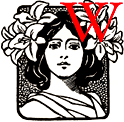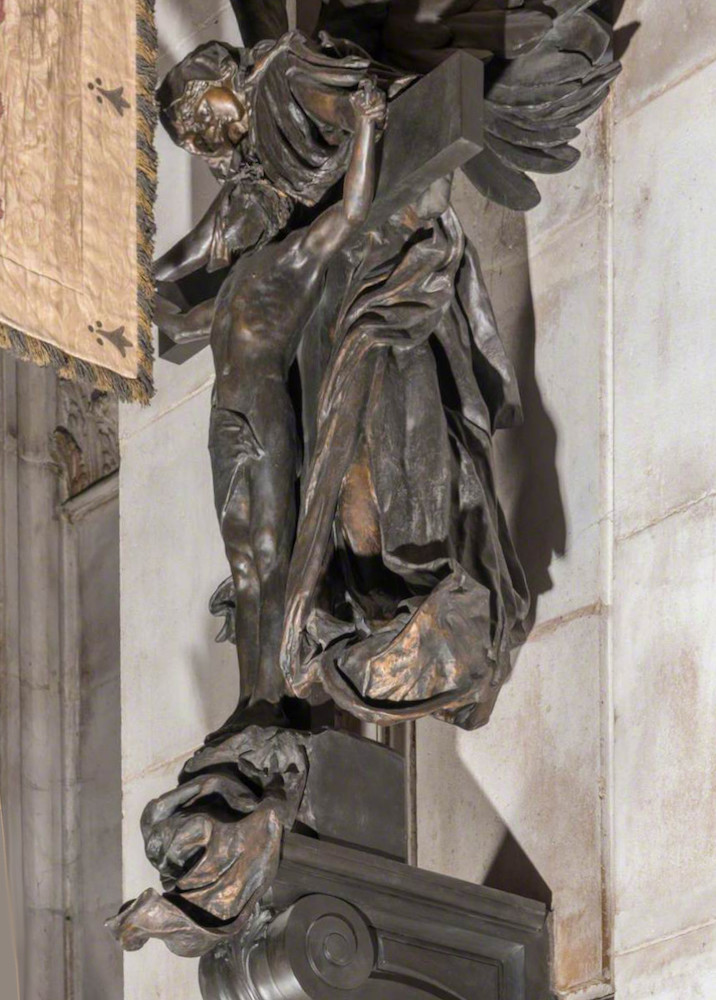Mosaics for St Paul's

illiam Blake Richmond, another long-standing friend and protégé of Leighton, was also inspired by Mary. He had a studio in the garden of his family home in Hammersmith. The whole complex was haunted by a number of ghosts, including Richmond's first wife, and required a partially successful exorcism by the Society for Psychical Research. From 1881, Richmond had a second studio in the Holland Park Road Studios, a few doors along from Leighton. Mary modelled for a pastel bust of St Joan (private collection), wearing armour and a distinctive winged helmet.

One of William Blake Richmonnd's angels in the spandrels of St Paul's, based on Mary Lloyd.
When Richmond was designing the monumental and controversial mosaics that decorate the dome of St Paul's Cathedral (1891-1904), he repurposed Mary as St Joan for the armoured and winged Angels of the Passion in the spandrels of the north arches, where again, like in Millais' St Stephen, her head is atop a male body — this time a solidly muscled one. There are a number of easel paintings for which Richmond could also have used Mary, but, as the faces of these figures are often generic, it is difficult to identify her precisely.
Boer War Memorial for the Colonial Forces
Richmond was also long-standing friend of Princess Louise, Queen Victoria's unconventional daughter and a talented sculptor. Louise's marble statue of her enthroned mother, commemorating the Queen's Silver Jubilee in 1887, stands on the east side of Kensington Palace. When Louise was planning a memorial to the colonial soldiers who had died in the Boer War, to be installed in St Paul's, she turned to Richmond for ideas and advice.
Louise's bronze group, an angel with great wings, bearing a Christ figure tenderly upwards, is similar to the figures of Sleep and Sarpedon in Richmond's picture, Sleep and Death Carrying the Body of Sarpedon into Lycia, 1879 (untraced). This was a Homeric subject which the Saturday Review had considered to possess "poetic feeling" and "classical grandeur." The picture remained in Richmond's possession until his death and so could have been studied by Louise on her visits to Richmond's home and studio. Richmond recommended Mary as a suitable model for Louise's angel as: "She has a splendid head, beautiful arms and is quite nice. No H's, but really refined."

The angel in Princess Louise's Boer War memorial in St Paul's, for which Mary was the model. [Click on the image form more information and to enlarge it.]
Mary would have posed for the angel in Louise's studio in the grounds of Kensington Palace. Also posing for the memorial, but not on the same occasions, as male and female models never posed together, was Antonio Corsi, Mary's "husband" from Millais' Speak! Speak!. Corsi was one of the most celebrated male models of the day, now cast as the Christ/Warrior figure. We do not know what Mary's experience of working with Louise was like, but the Princess preferred informality and Corsi later told how she would stand close to his bare chest, holding a lighted cigarette to his lips so that he could maintain the difficult pose without a break. Corsi later moved to America and became a celebrity appearing in silent films. Louise's memorial was installed in St Paul's in 1904, making it Mary's third appearance in the Cathedral. (Two other versions of the group are known - as memorials for Louise's brother-in-law, Prince Henry of Battenberg, in St. Mildred's Church, Whippingham, Isle of Wight, and for her father-in-law, the 8th Duke of Argyll, originally in the Argyll Mausoleum, now in the Visitor Centre, Kilmun, Cowal Peninsula, Scotland.)
The Royal Academy Schools
After the deaths of Leighton and Millais, Mary had begun to model for students at the Royal Academy Schools. The Academy Sitters' Books record her working there between 1899 and 1911 and signing her name for the receipt of her payments of seven or eight shillings a session for posing for the School of Painting, draped. Antonio Corsi and Rachel Lee were also posing at this time, but earning 10 shillings a session as nude models. On a couple of occasions Mary signs her name "Marie" Lloyd. John William Waterhouse was a Visitor in the School of Painting, setting the model in the required pose and correcting the students' work. He engaged Mary for sittings for "the head" and wrote asking her to be at the Schools "at a quarter before nine." We do not know whether she sat for any of Waterhouse's own pictures. Her features and dark hair are similar to a number of his painted women, but he often combined aspects of more than one model to achieve his distinctive type, so it is difficult to identify her precisely.
The Final Years
By the outbreak of the First World War, Mary's modelling career was over. She had suffered a long illness, exhausted her savings and had to turn to domestic work to earn her living. She had kept in touch with her former employer, the now widowed Kate Perugini, and helped out at her Argyll Mansions flat in South Kensington when Kate's usual staff were away. Mary also knew Kate's brother, the barrister Sir Henry Dickens, and may have worked for him too. She kept a card from Sir Henry and his wife, dating to sometime after 1922, sending their love and best wishes, the sort of thing that might have been attached to a bouquet of flowers. Kate Perugini died in 1929.
Mary's Final Appearance
We next hear of Mary in 1933, when a reporter from the Sunday Express interviewed her at Leighton House, not far from her address in Bedford Gardens. The article stated that Mary had grown up in luxury, the daughter of a Shropshire squire who had lost his money. She was now 70 years of age and described as "frail and old, with silver hair and soft brown eyes . . . . the subject of more world-famous masterpieces than any other woman alive." Mary stated that "one by one the artists died. Each year I grew poorer and poorer, and moved, as I did so, to humbler apartments." The photograph of Mary, in profile, accompanying the article, shows her gazing at a framed print of herself as Leighton's Atalanta. This is the image which Martin Postle compares to the head of Flaming June. As well as some of the artists covered in the above account, Edward Burne-Jones and William Holman Hunt were also mentioned in this article, but Mary has not been identified in their work. The article appeared on 22 October with the title "The Story of Mary Lloyd who had the face of an angel but outlived her luck." The account of Mary's straightened circumstances so touched some readers of the newspaper that they sent letters of sympathy and donations and an osteopath, Lionel Atherton, offered Mary a home where she would have her own room and live as one of the family. If she took up the offer, this would have been at Sun Haven, near Dorking, Surrey, where Atherton opened the "First British Osteopathic Hospital," an unconventional residential healing establishment, which also offered "psycho-therapy, botano-therapy" and astrology. The hospital was short-lived and closed in 1937, though there were twenty-two residents, including Atherton's family, still living there when he went bankrupt in 1939. Whether Mary was one of the twenty-two is unrecorded. At the time of writing, Mary's date and place of death are unknown.
Mary kept the artists' letters, the telegrams and invitations she had received, together with press cuttings, magazine articles and illustrations of pictures for which she had sat, plus a few photographs of herself. The latest piece of material is dated 1939. Then the trail goes cold. This small archive came up for sale in 2015. The purchaser very kindly donated it to Leighton House Museum.
From the foregoing, it is clear that Mary Lloyd was a major artists' model and the inspiration for a number of noted paintings and sculptures. Her busy career spanned the period 1892-1911. She was at the height of her success from 1893-98, when she was critical to the final masterworks of both Leighton and Millais. The other artists with whom she is associated were all pupils and followers of these two giants of Victorian art and much influenced by their classical, spiritual, supernatural and orientalist themes. As well as featuring sixteen times on the walls of the Royal Academy within five years, more than any other model of the period, Mary's image continued to appear into the twentieth century as the public memorials for which she posed were unveiled. Starting late as a model, she worked until nearly the age of 50, which is also unusual. However, the places and circumstances of her birth and death, including the date of the latter, are not known. Was she really the daughter of a bankrupt Shropshire squire, who had grown up in luxury? Or was this description a way of asserting her respectability and an excuse for her entry into modelling, which even in the 1930s might have raised eyebrows? We shall probably never know the full story of Mary Lloyd.
Links to Other Parts
- Part I: The First Sittings; the Royal Academy Exhibition of 1893
- Part II: Sitting for Millais; Mary and the Royal Academy Exhibition of 1894
- Part III: Mary and the Royal Academy Exhibition of 1895
- Part IV: After Leighton and Millais: 1896
Bibliography
Barrington, Emilie Russell. The Life, Letters and Work of Frederic Leighton. 2 vols., 1906. Both volumes available on Project Gutenberg Vol. 1: https://www.gutenberg.org/cache/epub/35934/pg35934-images.html; Vol. 2: https://www.gutenberg.org/cache/epub/35935/pg35935-images.html
Barrow, Rosemary J. Lawrence Alma Tadema. New York and London: Phaidon, 2012.
Brock, Frederick. Thomas Brock, Forgotten Sculptor of the Victoria Memorial. Edited by John Sankey. Bloomington, In.: Author House, 2012. Review]
Frederick, Margaretta S. "On Frederic Shields' Chapel of the Ascension, 1887-1910." BRANCH. https://branchcollective.org/?ps_articles=margaretta-s-frederick-on-frederic-shields-chapel-of-the-ascension.
Fine Art Society. "Lord Leighton's Last Picture: Clytie. An Illustrated Description, 1896.
Galliard, Ann. "Princess Louise, Duchess of Argyll: A Royal Artist." In Friends of the Argyll Papers, 2021.
Gerard-Powell, Veronique. A Victorian Obsession. The Perez Simon Collection at Leighton House Museum, Royal Borough of Kensington and Chelsea, 2014.
Hawksley, Lucinda. Katey, The Life and Loves of Dickens's Artist Daughter. London: Doubleday, 2006.
_____. The Mystery of Princess Louise: Queen Victoria's Rebellious Daughter. London: Chatto & Windus, 2013.
Hogger, C.J., and Susan Morris. "Lionel Atherton and the First Osteopathic Hospital." Effingham Local History Group, 2024.
How, Harry. "Sir Frederick (sic) Leighton, PRA." Illustrated Interviews. No XIV (1892).
Jiminez, Jill Berk, ed., with associate ed. Joanna Banham. Dictionary of Artist's Models. New York and London: Routledge, 2001.
Leighton's Appointments Diary, 1893 and Sitters' Books, 1897-1902 and 1906-1911. Royal Academy Library.
The Mary Lloyd Archive. Leighton House Museum.
Millais, John Guille. The Life and Letters of Sir John Everett Millais. 2 Vols. Vol. I. Vol. II. Toronto: George N. Morang. 1900. Internet Archive, from a copy in Trent University, Canada.
Postle, Martin. "Leighton's Lost Model, The rediscovery of Mary Lloyd." Apollo Magazine. 143 (February 1996): 27-29.
Prettejohn, Elizabeth, and Peter Trippi, ed. Lawrence Alma Tadema: At Home in Antiquity. Munich: Prestal Verlag, 2016.
Reynolds, Simon. William Blake Richmond, An Artist's Life, 1842-1921. Wilby, Norwich: Michael Russell, 1995.
Toll, Simon. Herbert Draper, 1863-1920: A Life Study. Woodbridge, Suffolk: Antique Collectors Club, 2003.
_____. Frank Dicksee, 1853-1928: His Art and Life. Woodbridge, Suffolk: ACC Artbooks, 2016.
Created 25 September 2024